Concrete has a wide range of applications in the construction field. However, the brittle characteristic of concrete is the key factor to induce cracks which may decrease the bearing capacity of concrete structures. Recently, a kind of ductility material which is called high ductility cementitious composites (HDCC) has been developed rapidly. The average ultimate tensile strain of HDCC is greater than 0.5%, and the average crack width is less than 200 μm[1]. HDCC has promising application in engineering projects due to its excellent ductility and tight crack width, and it has been used to cast bridge deck link slabs[2-3].
For the preparation of HDCC, fly ash substituting cement is a key ingredient to improve tensile ductility. Based on the design theory of HDCC, the chemical bonding force between the fibers and matrix can be decreased as the fly ash content increases, and more fibers are pulled out, which enhances the fiber bridging effect[4]. In addition, fly ash is a kind of industrial waste, and the utilization of fly ash can decrease the environmental burden. In addition, the workability of fresh HDCC can also be improved with the addition of fly ash at high volume, and it is critical for the application of it on-site. Moreover, fly ash generates less hydration heat and it can be used in mass HDCC engineering[5]. Therefore, many researchers are making efforts to develop HDCC with locally available fly ash.
The addition content of fly ash is important in regard to the mechanical property of HDCC. The dissolved Si and Al ions in fly ash can react with Ca(OH)2, and then the Ca-Si and Ca-Al hydrates productions are generated[6]. In addition, the pozzolanic reaction of fly ash is related to the Ca(OH)2 content in cementitious composites. The proportions of cement and fly ash in HDCC mixture are very important. If the ratio of fly ash to cement content is relatively high, the hydration of fly ash will be limited. So the rest fly ash acts as a filler even though HDCC has a long curing age. Therefore, the reaction degree of fly ash has to be analyzed as it affects the mechanical property of HDCC.
The effects of curing age on the mechanical property of HDCC have been reported by several researchers. A consistent conclusion can be drawn that the strength of HDCC in tension and compression increased as the curing age increased, while the tensile ductility and flexural deflection of HDCC decreased[7-9]. Thus, the mechanical property of HDCC changes with the increase in curing age. For the safety design of structure using HDCC material, it is critical to determine the design parameters reasonably. The compressive and tensile stress-strain relationships of HDCC are the key parameters in the design of structure, and thus they must be studied. A few researchers investigated the compressive and tensile stress-strain relationships of HDCC with different mixtures exposed to 28 d[10-11]. However, the effects of curing age on the stress-strain behaviors of HDCC in tension and compression have not been reported. In addition, to whether the stress-strain curve of HDCC with a curing age of 28 d was reasonable in this structure design, this issue will need to be further studied.
Compared with HDCC mixture, ecological HDCC (Eco-HDCC) mixture contains river sand and domestic PVA fiber. The preparation cost of Eco-HDCC is only about one third of that of traditional HDCC[12-14], and it can be widely used in structure engineering.
This study examined the effects of curing age on the stress-strain behaviors of Eco-HDCC in compression and tension. Moreover, the reaction degrees of fly ash and non-evaporable water content were calculated. In addition, the pH value in the pore solution of Eco-HDCC was also measured. Then, the simplified stress-strain curves of Eco-HDCC in compression and tension were suggested for structure design.
1 Experiment
1.1 Materials
The P·Ⅱ 42.5R Portland cement (C) and Class F fly ash (FA) were used as the binding materials. River sand (S) with a maximum diameter of 1.18 mm was selected as the fine aggregate. Its loose bulk density and fineness modulus were 1 570 kg/m3 and 1.68, respectively. PVA fiber produced in China was used to improve the ductility of the Eco-HDCC mixture, and the detailed property of PVA fiber is listed in Tab.1. Polycarboxylate superplasticizer (PS) and water (W) were used to adjust the workability of the fresh Eco-HDCC paste. Besides, the mixture proportion of Eco-HDCC with compressive strength level of C40 was chosen. The mass ratio of W to (C+FA) was 0.3, and the mass ratio of S to (C+FA) was also 0.3. In addition, the mass ratio of FA to C was 1.5 in order to ensure a higher tensile strain, and the mass ratio of PS to (C+FA) was 0.08% to adjust the workability of fresh Eco-HDCC. The PVA fiber was added into the mixture with a volume fraction of 2%.
Tab.1 Physical and mechanical properties of PVA fiber[14]

Length/ mmMean diameter/ μmDensity/ kg∙m-3 Ultimate elongation/%Ultimate tensile strength/MPaElastic modulus/GPa12391 3005~8≥1 25030
1.2 Specimen preparation
The preparation process of Eco-HDCC was described in Ref.[14]. According to the Test Method for Fluidity of Cement Mortar (GB/T 2419—2005), the fluidity of fresh Eco-HDCC was measured. Specimens of Eco-HDCC cement-fly ash paste (Eco-HDCC-CF, Eco-HDCC mixtures excluding sand and PVA fibers) were also prepared. The Eco-HDCC-CF specimen was used to evaluate the reaction degree of fly ash and non-evaporable water content. All tests were conducted at the curing ages of 28, 56, 90 d.
The dimensions and amounts of specimens used in the study are presented in Tab.2[1]. Besides, all specimens were cured under the standard curing conditions at the temperature of (20±2) ℃ and relative humidity of 95%.
Tab.2 The dimensions and amounts of Eco-HDCC specimens

ProjectsDimension/ mm×mm×mm Amount per ageCubic compressive strength100×100×1003Compressive stress-strain be-havior100×100×3003Tensile stress-strain behavior13×30×100 middle zone of dog-bone specimen 3Reaction degree of fly ash non-evaporable water content40×40×1603
1.3 Test programs
1.3.1 Stress-strain behavior of Eco-HDCC
The compressive property of Eco-HDCC was examined by a universal testing machine with 3 000 kN capacity. The loading rate of cubic compressive strength was 0.5 MPa/s. The compressive stress-strain behavior of Eco-HDCC was measured by the vertical strain gauges and linear variable differential transformer (LVDT). The strain gauges and LVDT were set in the middle 1/3 part of the Eco-HDCC prism specimen since the middle zone was close to the uniaxial compressive condition. Also, the compressive elastic modulus of Eco-HDCC was calculated by vertical strain gauges. The horizontal strain gauges were also pasted on the middle zone in order to obtain a Poisson’s ratio of Eco-HDCC. To obtain a stable compressive stress-strain relationship curve, the load was applied by displacement control at a loading rate of 0.3 mm/min. The test setup of the compressive stress-strain property is shown in Fig.1(a).
The tensile property test of Eco-HDCC was performed by a dog-bone specimen, and the middle zone with a dimension of 100 mm was close to the uniaxial tensile condition. Besides, a LVDT was used to measure the tensile stress-strain relationship curve. The loading rate of the tensile property test was 0.2 mm/min. The test setup of tensile stress-strain behavior is shown in Fig.1(b).
1.3.2 Reaction degree of fly ash
Eco-HDCC-CF specimens were drilled into powders, and the powders were screened by a 0.075 mm sieve. To eliminate the carbonation effect, the powders were obtained in the central zone of the specimen. Hydrochloric acid (HCl) solution was selected to examine the reaction degree of fly ash. As unhydrated cement and hydration products can be dissolved by HCl solution, and unhydrated fly ash was residual, the reaction degree of fly ash can be measured by the mass ratio of hydrated fly ash and original Eco-HDCC-CF[9, 15].
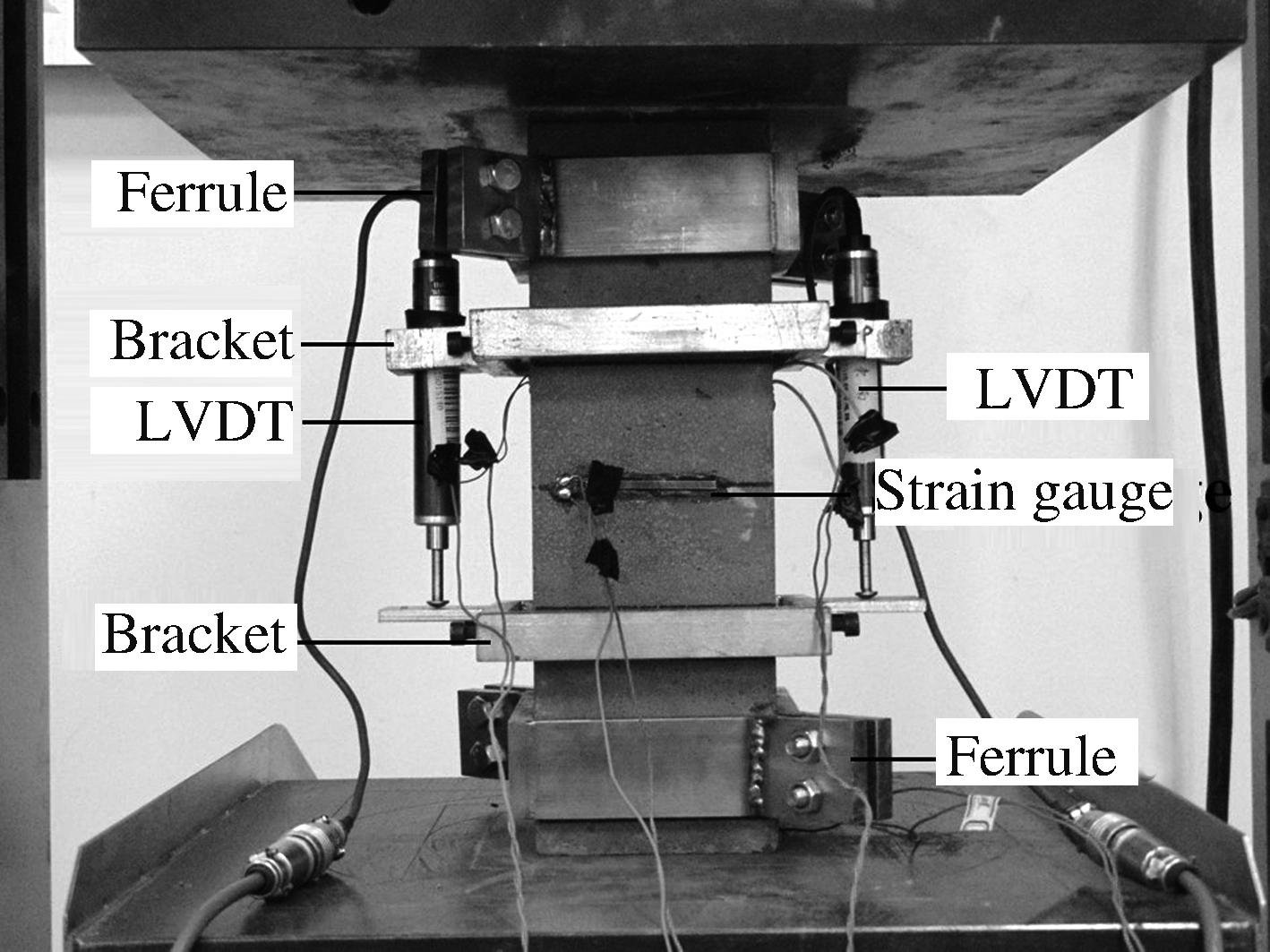
(a)

(b)
Fig.1 Test setup of mechanical property for Eco-HDCC. (a) Compressive stress-strain behavior; (b) Tensile stress-strain behavior
1.3.3 Non-evaporable water content
The loss on ignition was used to evaluate the non-evaporable water content of Eco-HDCC-CF. Powders were set in the dry oven at a constant temperature of 105 ℃ for 4 d to ensure the absence of evaporable water. Then, powders of approximately 1 g were placed in the muffle furnace with a constant temperature of 950 ℃ for 1 h. After that, powders were transferred into the desiccator for natural cooling. Furthermore, the cooling powders were measured[9, 16]. According to the loss on ignition of Eco-HDCC-CF powders and raw materials (C and FA), the non-evaporable water content was calculated.
1.3.4 The pH value in pore solution
Eco-HDCC powders were mixed with deionized water in a sealed container, and the ratio of solid to liquid was 1∶10[17]. Besides, the solution was put in the lab for 15 d with a room temperature of 20 ℃. The test of pH value in the pore solution was conducted using a pH microelectrode. In addition, to obtain the Ca(OH)2 content in Eco-HDCC, the differential scanning calorimetry-thermal gravimetric (DSC-TG) test was performed[14].
2 Results and Discussion
The fresh Eco-HDCC pastes have a fluidity of (190±3) mm in the test. The cubic compressive strengths of Eco-HDCC with 28, 56 and 90 d curing ages are 43.8, 48.7 and 53.0 MPa, respectively. The compressive strength level of Eco-HDCC is C40. As curing age increases, the compressive strength of Eco-HDCC increases. This is attributed to the further hydration of cementitious materials.
2.1 Compressive stress-strain behavior
The compressive stress-strain behaviors of Eco-HDCC after different curing ages are shown in Fig.2. All stress-strain curves of Eco-HDCC have three stages: the linear elastic stage, non-linear stage and softening stage. Besides, as curing age increases, the descending curve of Eco-HDCC displays a steeper trend, which indicates a sudden failure of the Eco-HDCC specimen. In addition, at the post-peak stage of Eco-HDCC, the slope of the curve represents the compressive ductility[18-19]. As the curing age increases, the compressive ductility of Eco-HDCC decreases.
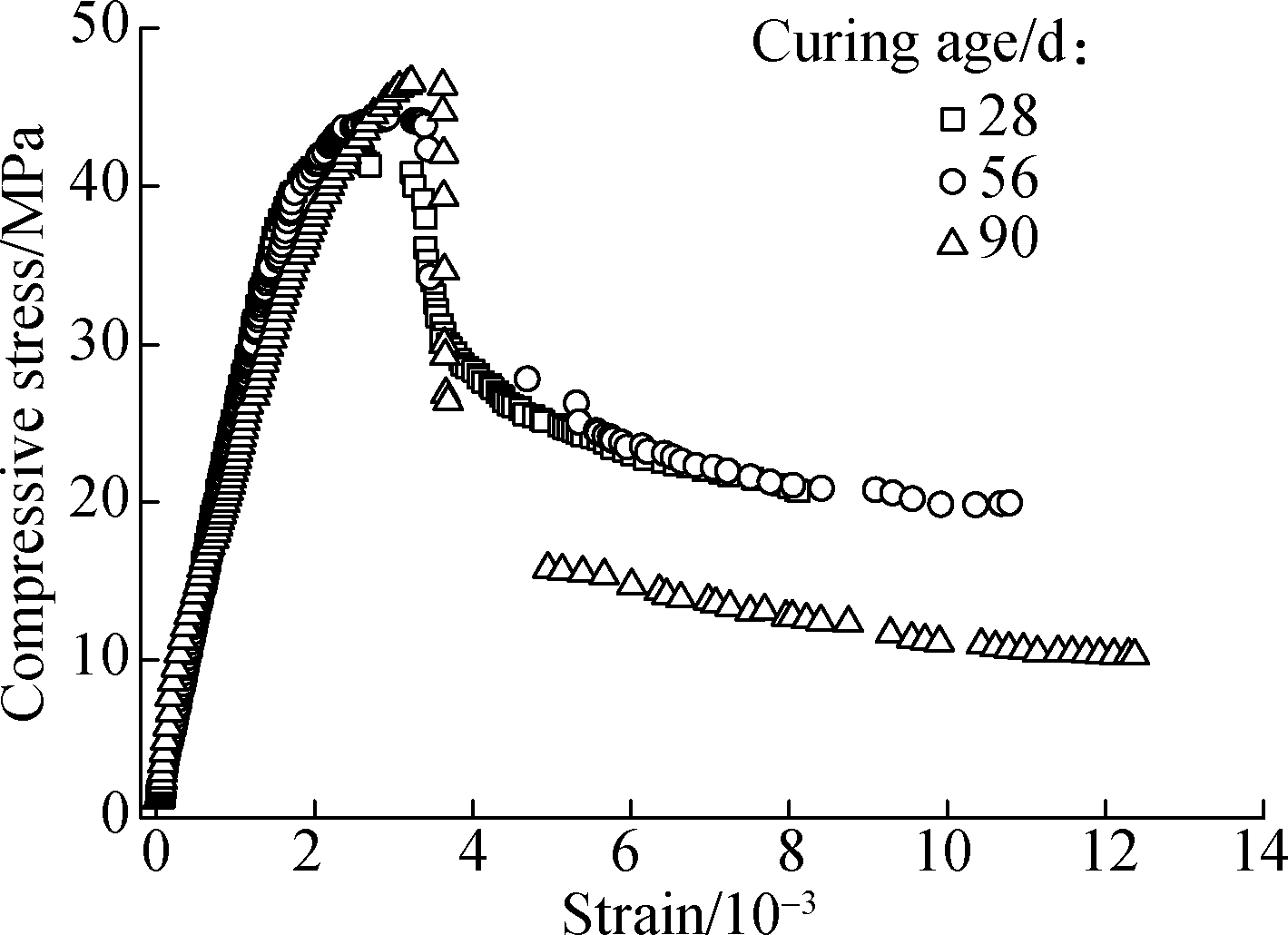
Fig.2 Compressive stress-strain relationship curves of Eco-HDCC
At the initial stage, the compressive stress-strain relationship of Eco-HDCC is linear, and the stage is elastic. After the compressive loading reaches approximately one third of peak loading, the curve exhibits a non-linear characteristic due to the cracks. As loading increases, the compressive loading reaches a peak value. After the peak value, the curve shows a softening descending characteristic. At the softening stage, the major crack occurs in the Eco-HDCC specimen as failure localizes.
The characteristic points of compressive stress-strain curves for Eco-HDCC after different curing ages are different, and the characteristic points are listed in Tab.3. As the curing age increases, the peak compressive stress, ultimate compressive stress and compressive elastic modulus of Eco-HDCC increase. For the curing age of 90 d, the increase amplitudes of the peak compressive stress and compressive elastic modulus are 11.5% and 13.3%, respectively. With the increase in curing age, the peak compressive strain of Eco-HDCC increases while the ultimate compressive strain decreases. For the curing age of 90 d, the increase amplitudes of the peak compressive strain and ultimate compressive strain are 29.3% and -49.4%. In addition, Poisson’s ratio shows little change as the curing age increases.
The further hydration of cementitious materials results in the increase in the peak compressive stress (uniaxial compressive strength) and peak compressive strain[20]. A higher uniaxial compressive strength leads to a sudden failure of Eco-HDCC, resulting in a lower ultimate compressive strain. Although the compressive elastic modulus of Eco-HDCC increases as uniaxial compressive strength increases, its value is also lower than that of normal concrete. This is attributed to the absence of coarse aggregates in Eco-HDCC. Due to the bridging effect of the fibers, Poisson’s ratio of Eco-HDCC is larger than that of normal concrete (0.22).
Tab.3 shows the characteristic points of compressive stress-strain curve for Eco-HDCC. Here, fcu,k is the cubic compressive strength; σc,ris the peak compressive stress of the compressive stress-strain curve, and σc,u is the ultimate compressive stress of compressive stress-strain curve when the stress declines to 50% of peak compressive stress; εc,ris the peak compressive strain corresponding to peak compressive stress, and εc,u is the ultimate compressive strain corresponding to ultimate compressive stress; Ec is the compressive elastic modulus; ν is Poisson’s ratio. From Tab.3, it can be seen that the ratio of uniaxial compressive strength to cubic compressive strength for Eco-HDCC is larger than that of normal concrete (the ratio value is 0.75 in concrete structure code). Thus, in the design of the Eco-HDCC structure, the uniaxial compressive property should be considered. In addition, the ratio of ultimate compressive strain to peak compressive strain decreases as strength increases, and the phenomenon is consistent with that of normal concrete.
Tab.3 Characteristic points of compressive stress-strain curve for Eco-HDCC

Curing age/dσc r/MPaσc u/MPaεc r/10-3εc u/10-3Ec/GPaνσc rfcu kεc uεc r2841.8±2.020.92.491±0.1458.000±0.21322.6±0.40.26±0.010.953.25644.4±1.822.22.918±0.2137.040±0.36923.5±0.30.25±0.010.912.49046.6±2.223.33.220±0.1584.052±0.45325.6±0.30.25±0.010.881.3
Curing age has a positive effect on compressive strength, so the compressive stress-strain relationship of Eco-HDCC with a curing age of 28 d can be used in Eco-HDCC structure design conservatively. Besides, to facilitate the design of the Eco-HDCC structure, a fitting curve is suggested. The fitting curve is according to the test data of Eco-HDCC after 28 d curing age, as shown in Fig.3.
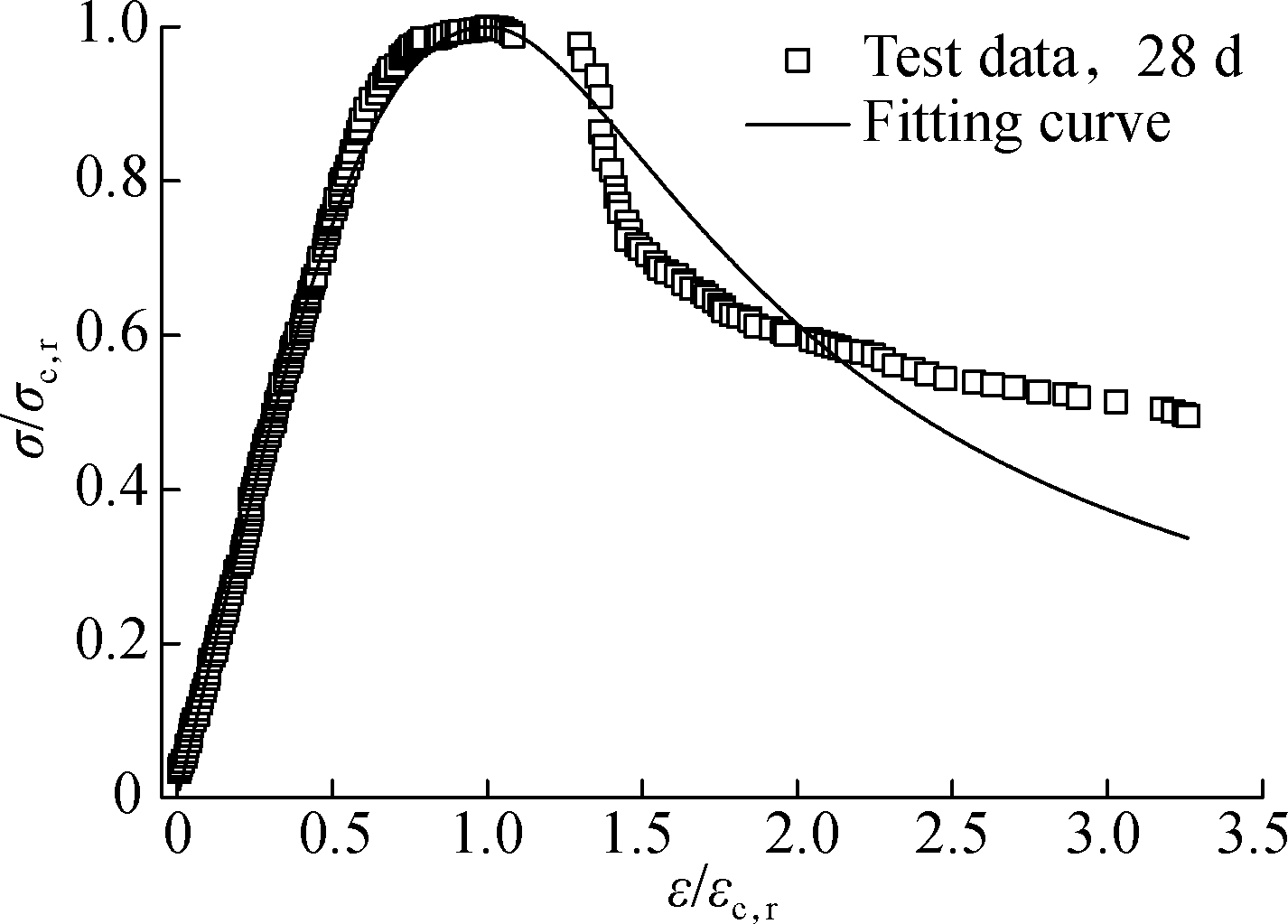
Fig.3 Fitting compressive stress-strain relationship curve of Eco-HDCC
The test data is fitted by the following equations:
(1)
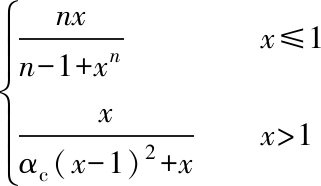
(2)
where σ is the compressive stress; ε is the compressive strain; n is the parameter reflecting the ascending trend of compressive stress-strain curve, and the value is 2.52 with a fitting coefficient of 0.997 in the study; αc is the parameter reflecting the descending trend, and the value is 1.26 with a fitting coefficient of 0.711. These equations were originally developed from normal concrete[18-19], and they are extended to fit the curves of Eco-HDCC.
2.2 Tensile stress-strain behavior
The tensile stress-strain behaviors of Eco-HDCC at different curing ages are presented in Fig.4. The tensile stress-strain curves of Eco-HDCC exhibit four stages: the linear elastic stage, non-linear stage, strain hardening stage and softening stage. The detailed descriptions were shown in Ref.[14]. Eco-HDCC has an inherent characteristic of strain hardening. Besides, the strain hardening curve has a more obvious characteristic of “jump” and “drop” as the curing age increases. The tensile property is mainly related to the matrix strength, fiber property and fiber/matrix interfacial property[4]. As the curing age increases, both the matrix strength and fiber/matrix interfacial strength increase. Then, more fibers will be ruptured suddenly during the process of tensile loading, resulting in a weaker bridging effect of the fiber. Thus, the tensile loading is not stably transferred by the fibers crossing the cracks, which leads to a sudden “drop” and “jump” characteristic in the strain hardening curves.
The curing age has an impact on the characteristic points of the tensile property for Eco-HDCC, as shown in Tab.4. Here, σt,f is the first cracking tensile strength; εt,fis the first cracking tensile strain; Et is the tensile elastic modulus; σt,u is the ultimate tensile strength; εt,u is the ultimate tensile strain. As the curing age increases, the first cracking tensile strength, the first cracking tensile strain and tensile elastic modulus of Eco-HDCC increase. Besides, with the increase in the curing age for Eco-HDCC, the ultimate tensile strength increases while the ultimate tensile strain displays the opposite trend.
At the initial stage, the matrix of Eco-HDCC bears tensile loading. The further hydration of cementitious composites causes higher matrix strength. Therefore, the first cracking tensile strength and ultimate tensile strength of the matrix in Eco-HDCC increase as the curing age increa-ses. Besides, the tensile elastic modulus of Eco-HDCC is related to the matrix strength, and higher matrix strength results in a higher elastic modulus. Notably, the tensile elastic modulus of Eco-HDCC is lower than the compressive elastic modulus. The compressive strength and strain of Eco-HDCC are larger than the tensile strength and strain. Before the first cracking point, the tensile strain capacity of Eco-HDCC is related to the strain of the matrix. Then, the first cracking tensile strain capacity of Eco-HDCC increases as the matrix strength increases. After the matrix cracks, a fiber bridging effect acts and fibers crossing the cracks bear the tensile loading, so that the tensile strain increases as tensile loading increases. The matrix strength and fiber/matrix interfacial strength will be higher due to the further hydration of cementitious composites. Due to the higher fiber/matrix interfacial strength, more fibers are ruptured during the process of pull-out, and the fiber bridging effect will be poor. Thus, the ultimate tensile strain of Eco-HDCC decreases as the curing age increases.
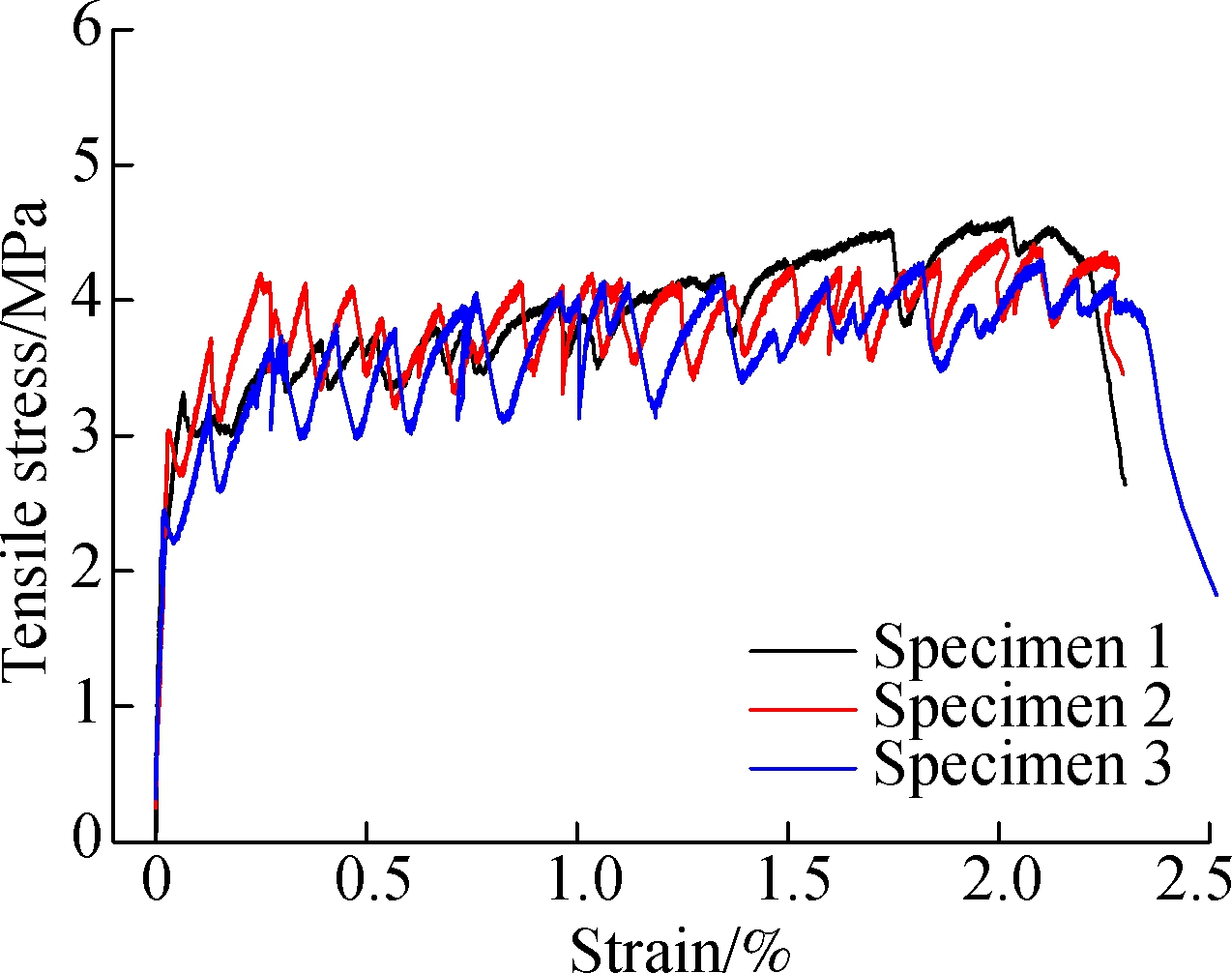
(a)

(b)
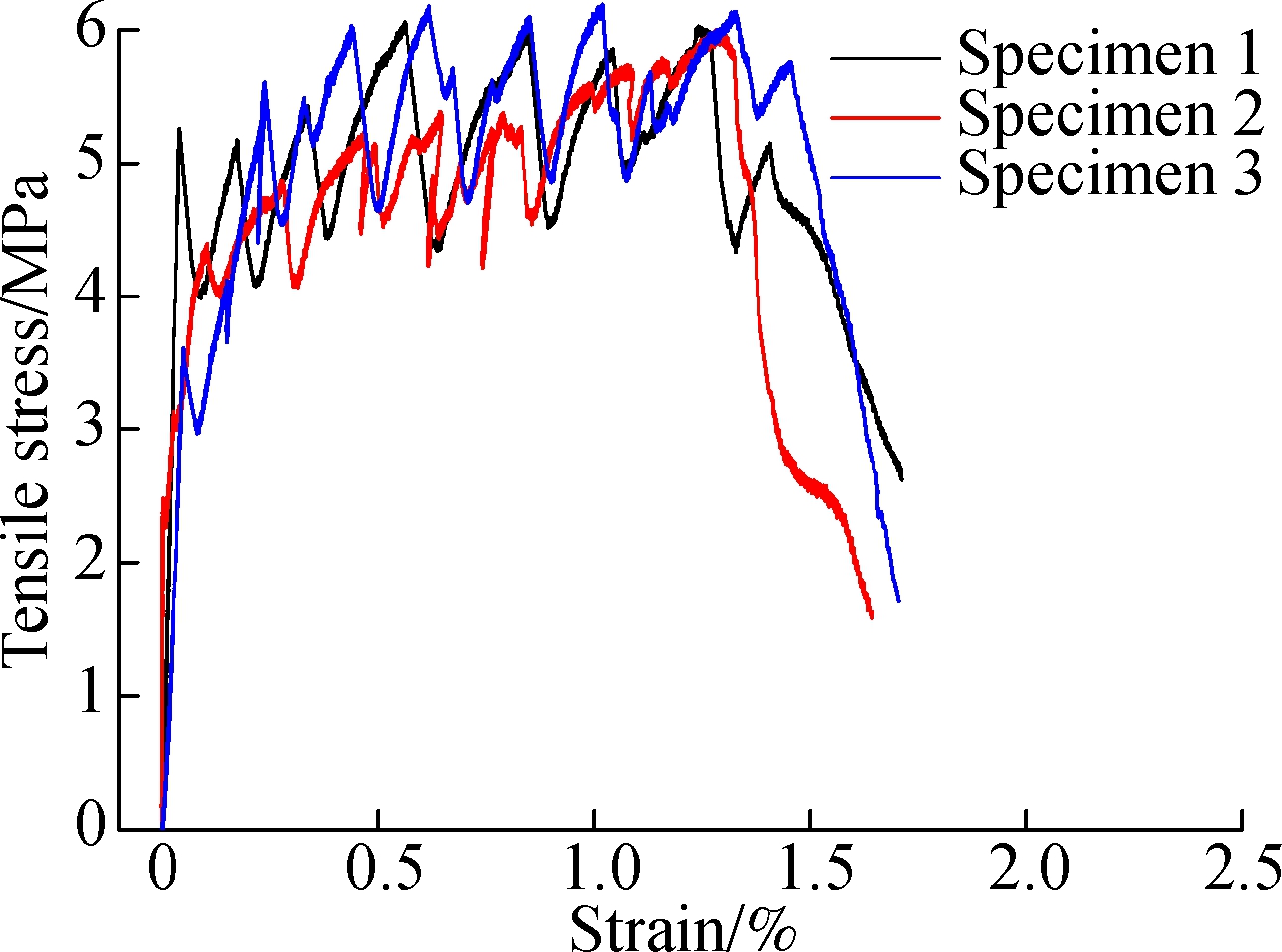
(c)

(d)
Fig.4 Tensile stress-strain relationship curves of Eco-HDCC with different curing ages. (a) 28 d; (b) 56 d; (c) 90 d; (d) Comparisons of different curing ages
Tab.4 Characteristic points of tensile stress-strain curve for Eco-HDCC

Curing age/dσt f/MPaεt f/%Et/GPaσt u/MPaεt u/%282.12±0.060.02±0.00211.5±0.54.43±0.132.04±0.05563.25±0.780.03±0.00512.9±0.95.65±0.211.61±0.03903.60±1.020.04±0.00713.3±1.26.03±0.071.28±0.04
The curing age has a positive effect on the ultimate tensile strength, while it has a negative effect on the ultimate tensile strain. The tensile stress-strain relationship curve of Eco-HDCC with a curing age of 28 d can be used in structure design due to the lower ultimate tensile strength. Besides, when the Eco-HDCC is used to cast the bridge deck link slab, the decrease degree of ultimate tensile strain for Eco-HDCC is 0.5 after being exposed to 15 interactive cycles[14]. Thus, a reduction factor of 0.5 can be considered for the ultimate tensile strain due to the long-term curing. For the Eco-HDCC with a curing age of 28 d, the ultimate tensile strain can be taken as 1.00 % in the design of the structure. A simplified bilinear tensile stress-strain relationship model is suggested based on the test data of Eco-HDCC with a curing age of 28 d, as shown in Fig.5.
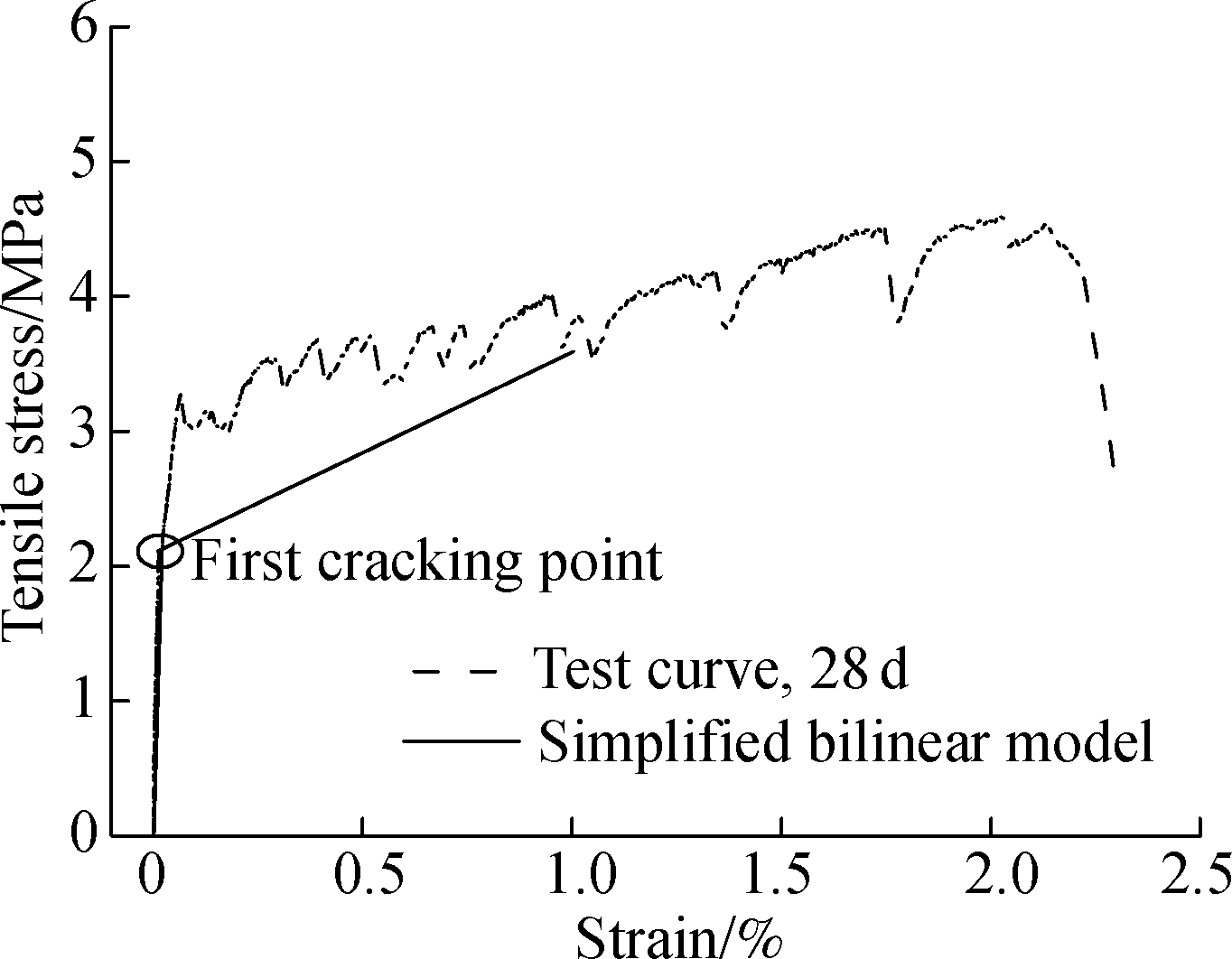
Fig.5 The simplified bilinear tensile stress-strain relationship model of Eco-HDCC
The first tensile stress-strain stage of Eco-HDCC is determined by a straight line from the initial loading point to first cracking point. Besides, the strain hardening stage of Eco-HDCC is similar to the“yield stage” of the steel bar. The yield strength of the steel bar is based on the lower yield strength. Thus, the second stage of the tensile stress-strain model is determined by the straight line from the first cracking point to the “lower yield point”. The lower yield point of Eco-HDCC is based on the value corresponding to the tensile strain of 1.00%. The bilinear model is given as

(3)
where σt is the tensile stress; εt is the tensile strain; σt,1% is the tensile stress corresponding to the tensile strain of 1.00%; εt,1% is the tensile strain of 1.00%. In the study, the detailed equations can be illustrated as
(4)
2.3 Reaction degree of fly ash
The reaction degrees of fly ash in Eco-HDCC-CF specimens are shown in Tab.5. As the curing age increases, the reaction degree of fly ash increases due to the pozzolanic reaction while the increase degree decreases. The pozzolanic reaction of fly ash has a direct correlation with the Ca(OH)2 content produced by cement hydration. The slower hydration of cement in Eco-HDCC after curing age of 90 d leads to a lower amount of Ca(OH)2. Besides, fly ash reacts with Ca(OH)2, but the out-layer hydration products hinder the reaction of inner fly ash. Therefore, the increase degree of reaction degree for fly ash in Eco-HDCC decreases at the curing age of 90 d. The further reaction of fly ash increases the fiber/matrix interfacial strength, resulting in the rupture of more fibers during the process of pull-out. Then, the fiber bridging effect will be weaker, resulting in a lower ultimate tensile strain.
Tab.5 Hydration reaction degree and pH values in the pore solution of Eco-HDCC

Curing age/dReaction degree of fly ash/%Non-evaporable water content/%pH value in pore solutionCa OH 2content/%2816.3810.1212.346.845621.6111.3712.205.499024.3211.7212.085.09
2.4 Non-evaporable water content
The non-evaporable water content can indirectly reflect the hydration products in cementitious composites. As the curing age increases, the non-evaporable water contents increase, as shown in Tab.5. Besides, the increase degree of non-evaporable water content in Eco-HDCC-CF with a curing age of 90 d is lower than that of Eco-HDCC-CF with a curing age of 56 d. Although the hydrations of cement and fly ash are continuous, the reaction speed decreases after the curing age of 56 d. On the one hand, the out-layer hydration products block the reactions of inner cement and fly ash, resulting in the lower reaction speed. On the other hand, the decrease of Ca(OH)2 content leads to the lower reaction speed of fly ash. In addition, the increase in hydration products content results in a greater matrix strength and matrix/fiber interfacial strength. Consequently, the compressive strength and tensile strength of Eco-HDCC increase with the increase in curing age. Moreover, the higher matrix/fiber interfacial strength leads to a poorer fiber bridging effect, and the ultimate tensile strain of Eco-HDCC decreases.
2.5 The pH value in pore solution
From Tab.5, as the curing age increases, the pH value in pore solution decreases. The consumption of Ca(OH)2 content in Eco-HDCC can be used to explain the phenomenon.
Based on the DSC-TG method, the Ca(OH)2 content in Eco-HDCC decreases with the increase in curing age. Due to the continuity of cement hydration, Ca(OH)2 productions increase as the curing age increases but its increase rate decreases. While fly ash reacts with Ca(OH)2, and the reaction degree of fly ash increases with the increase in curing age, the comprehensive effects lead to the decrease of Ca(OH)2 and the pH value in the pore solution of Eco-HDCC. Although the pH value in the pore solution of Eco-HDCC is higher than 11.5 (the passivation film threshold of the steel bar) in the test, the carbonation effect of Eco-HDCC should be focused on and the pH value in the pore solution should be monitored. Notably, the pH value in the pore solution of Eco-HDCC is a key indicator for determining the cover thickness and bar type in the design of the structure.
3 Conclusions
1) As the curing age increases, the compressive and tensile strengths of Eco-HDCC increase. The reaction degree of fly ash and content of non-evaporable water become higher with the increase in curing age, resulting in the larger strength of matrix and matrix/fiber interface. Besides, the increasing curing age has a positive effect on the compressive and tensile elastic modulus of Eco-HDCC.
2) The ultimate compressive strain and ultimate tensile strain of Eco-HDCC display a decreasing trend with the increase in curing age. The weaker fiber bridging effect can be used to explain the phenomenon.
3) Considering the lower strength of Eco-HDCC with the curing age of 28 d, the compressive and tensile stress-strain relation are estimated. In particular, the ultimate tensile strain of 1.00% can be used in the design of structure made of Eco-HDCC materials.
[1]China Building Materials Federation. JC/T 2461—2018 Standard test method for the mechanical properties of ductile fiber reinforced cementitious composites [S]. Beijing: China Building Materials Press, 2018. (in Chinese)
[2]Lepech M D, Li V C. Application of ECC for bridge deck link slabs[J].Materials and Structures, 2009, 42(9): 1185-1195. DOI:10.1617/s11527-009-9544-5.
[3]Guo L P, Zhu C D, Fan Y G, et al. Design and application of high ductility cementitious composite(HDCC) for bridge deck link slab repairing [J]. China Concrete and Cement Products, 2016(12): 36-39. DOI:10.19761/j.1000-4637.2016.12.008. (in Chinese)
[4]Li V C, Leung C K Y. Steady-state and multiple cracking of short random fiber composites[J].Journal of Engineering Mechanics, 1992, 118(11): 2246-2264. DOI:10.1061/(asce)0733-9399(1992)118:11(2246).
[5]Yu J, Leung C K Y. Strength improvement of strain-hardening cementitious composites with ultrahigh-volume fly ash[J].Journal of Materials in Civil Engineering, 2017, 29(9): 05017003. DOI:10.1061/(asce)mt.1943-5533.0001987.
[6]Cho Y K, Jung S H, Choi Y C. Effects of chemical composition of fly ash on compressive strength of fly ash cement mortar[J].Construction and Building Materials, 2019, 204: 255-264. DOI:10.1016/j.conbuildmat.2019.01.208.
[7]Zhu Y, Zhang Z C, Yao Y, et al. Effect of water-curing time on the mechanical properties of engineered cementitious composites[J].Journal of Materials in Civil Engineering, 2016, 28(11): 04016123. DOI:10.1061/(asce)mt.1943-5533.0001636.
[8]Yang E H, Yang Y Z, Li V C. Use of high volumes of fly ash to improve ECC mechanical properties and material greenness [J]. ACI Materials Journal, 2007, 104(6): 620-628. DOI:10.14359/18966.
[9]Zhang Z G, Zhang Q. Self-healing ability of engineered cementitious composites (ECC) under different exposure environments [J]. Construction and Building Materials, 2017, 156: 142-151. DOI: 10.1016/j.conbuildmat.2017.08.166.
[10]Zhang J, Gong C X, Guo Z L, et al. Mechanical performance of low shrinkage engineered cementitious composite in tension and compression[J].Journal of Composite Materials, 2009, 43(22): 2571-2585. DOI:10.1177/0021998309345303.
[11]Zhou J J, Pan J L, Leung C K Y. Mechanical behavior of fiber-reinforced engineered cementitious composites in uniaxial compression[J].Journal of Materials in Civil Engineering, 2015, 27(1): 04014111. DOI:10.1061/(asce)mt.1943-5533.0001034.
[12]Zhang L H, Guo L P, Sun W, et al. Rheological property and fiber dispersion of high ductility cementitious composites [J]. Journal of Southeast University (Natural Science Edition), 2014, 44(5): 1037-1040. DOI: 10.3969 / j.issn.1001-0505.2014.05.028. (in Chinese)
[13]Chai L J, Guo L P, Chen B, et al. Anti-freezing property of ecological high ductility cementitious composites under freeze-thaw cycles [J]. Journal of Southeast University (Natural Science Edition), 2018, 48(3): 543-548.DOI: 10.3969/j.issn.1001-0505.2018.03.024. (in Chinese)
[14]Zhang L H, Chang C, Guo L P. Key mechanical properties and cost analysis of ecological high ductility cementitious composites [J]. Concrete, 2015 (1): 105-110+114. DOI: 10.3969/j.issn.1002-3550.2015.01.027. (in Chinese)
[15]China Building Materials Federation. GB/T 12960—2007 Quantitative determination of constituents of cement [S]. Beijing: China Standards Press, 2007. (in Chinese)
[16]Jia Y T. The hydration mechanism of the BFS and FA cement based materials [D]. Nanjing: Southeast University, 2005. (in Chinese)
[17]Chang C F, Chen J W. The experimental investigation of concrete carbonation depth[J].Cement and Concrete Research, 2006, 36(9): 1760-1767. DOI:10.1016/j.cemconres.2004.07.025.
[18]Wang W J, Zhao L, Liu Y Z, et al. Mechanical properties and stress-strain relationship in axial compression for concrete with added glazed hollow beads and construction waste[J].Construction and Building Materials, 2014, 71: 425-434. DOI:10.1016/j.conbuildmat.2014.05.005.
[19]Ministry of Housing and Urban-Rural Development of the People’s Republic of China. GB 50010—2010 Code for design of concrete structures [S]. Beijing: China Academy of Building Research, 2010. (in Chinese)
[20]Kan L L, Shi R X, Zhu J. Effect of fineness and calcium content of fly ash on the mechanical properties of engineered cementitious composites (ECC)[J].Construction and Building Materials, 2019, 209: 476-484. DOI:10.1016/j.conbuildmat.2019.03.129.